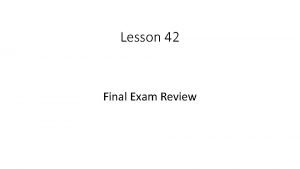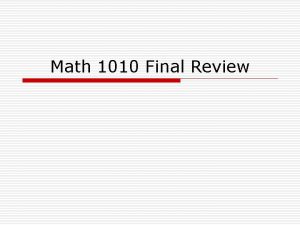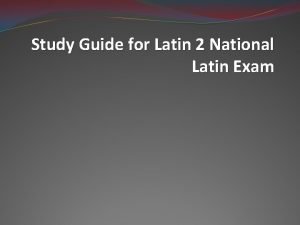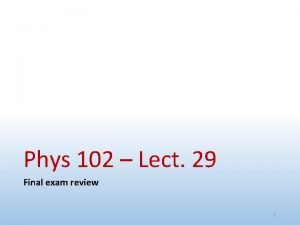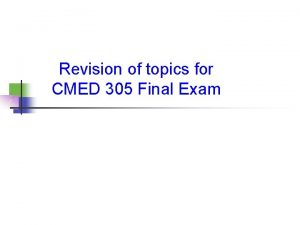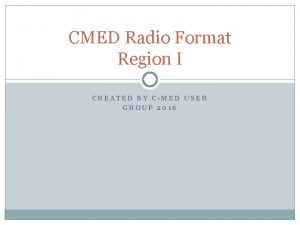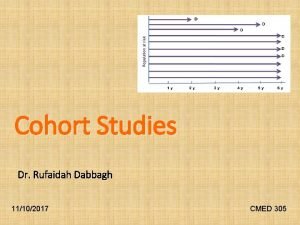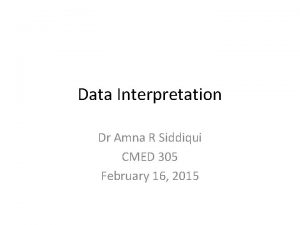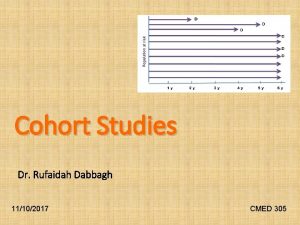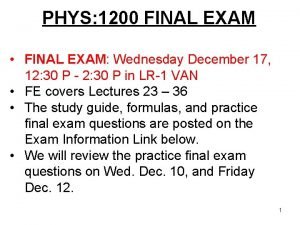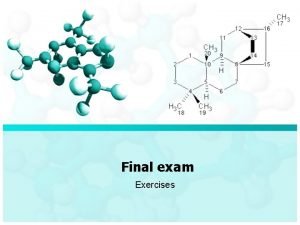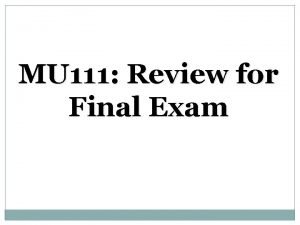REVISION OF TOPICS FOR CMED 305 FINAL EXAM








































- Slides: 40

REVISION OF TOPICS FOR CMED 305 FINAL EXAM

The exam duration: 1 hour 30 min. Marks : 25 All MCQ’s. You should choose the correct answer. No major calculations, but simple maths IQ is required. No need to memorize the formulas. Bring your own calculator. Cell phones are not allowed to use as a calculator.

Research Methodology: Incidence and Prevalence (2) Study Designs (Casecontrol, Cohort, Experimental, Cross sectional) (3) Odds Ratio and Relative Risk (2) Designing questionnaire and Study Tools for data collection (1) Data Interpretation (2) Biostatistics Topics: ( 40 questions) Sampling Techniques (4) Sample size (2) Type of data & graphical presentation(4) Summary and Variability measures (7) Normal distribution (2) Statistical significance using p-values (6) Statistical significance using confidence intervals (5) Statistical tests for quantitative variables (5) Statistical tests for qualitative variables (4) Spss software (1)

SAMPLING METHODS Probability Sampling Simple random sampling Stratified random sampling Systematic random sampling Cluster (area) random sampling Multistage random sampling Non-Probability Sampling Deliberate (quota) sampling Convenience sampling Purposive sampling Snowball sampling Consecutive sampling

Estimation of Sample Size by Three ways: By using (1) Formulae (manual calculations) (2) Sample size tables or Nomogram (3) Softwares

SCALES OF MEASURE Nominal – qualitative classification of equal value: gender, race, color, city Ordinal - qualitative classification which can be rank ordered: socioeconomic status of families Interval - Numerical or quantitative data: can be rank ordered and sizes compared : temperature Ratio - Quantitative interval data along with ratio: time, age.

TYPES OF DATA QUALITATIVE DATA (Categorical data) DISCRETE QUANTITATIVE CONTINOUS QUANTITATIVE

Categorical data --- Bar diagram (one or two groups) --- Pie diagram Continuous data --- Histogram --- Frequency polygon (curve) --- Stem-and –leaf plot --- Box-and-whisker plot --- Scatter diagram

Describing Data Numerically Central Tendency Quartiles Variation Shape Arithmetic Mean Range Median Interquartile Range Mode Variance Geometric Mean Standard Deviation Skewness Harmonic Mean 9

DISTRIBUTION OF DATA IS SYMMETRIC ---- USE MEAN & S. D. , DISTRIBUTION OF DATA IS SKEWED ---- USE MEDIAN & QUARTILES(IQR)

Bell-Shaped (also known as symmetric” or “normal”) Skewed: positively (skewed to the right) – it tails off toward larger values negatively (skewed to the left) – it tails off toward smaller values 11

VARIANCE: Deviations of each observation from the mean, then averaging the sum of squares of these deviations. STANDARD DEVIATION: “ ROOT- MEANS-SQUARE-DEVIATIONS”

STANDARD ERROR OF THE MEAN Standard error of the mean (sem): Comments: n = sample size even for large s, if n is large, we can get good precision for sem always smaller than standard deviation (s)

Standard error of mean is calculated by:

NORMAL DISTRIBUTION Many biologic variables follow this pattern Hemoglobin, Cholesterol, Serum Electrolytes, Blood pressures, age, weight, height One can use this information to define what is normal and what is extreme In clinical medicine 95% or 2 Standard deviations around the mean is normal Clinically, 5% of “normal” individuals are labeled as extreme/abnormal We just accept this and move on.


CHARACTERISTICS OF NORMAL DISTRIBUTION Symmetrical about mean, Mean, median, and mode are equal Total area under the curve above the x-axis is one square unit 1 standard deviation on both sides of the mean includes approximately 68% of the total area 2 standard deviations includes approximately 95% 3 standard deviations includes approximately 99%

Measures of Position z score Sample x x z= s Population x µ z=

Interpreting Z Scores Unusual Values -3 Ordinary Values -2 -1 0 Z Unusual Values 1 2 3

Hypothesis NULL HYPOTHESIS ‘No difference ‘ or ‘No association’ Alternative hypothesis Logical alternative to the null hypothesis ‘There is a difference’ or ‘Association’ simple, specific, in advance

TYPE I & TYPE II ERRORS Every decisions making process will commit two types of errors. “We may conclude that the difference is significant when in fact there is not real difference in the population, and so reject the null hypothesis when it is true. This is error is known as type-I error, whose magnitude is denoted by the Greek letter ‘α’. On the other hand, we may conclude that the difference is not significant, when in fact there is real difference between the populations, that is the null hypothesis is not rejected when actually it is false. This error is called type-II error, whose magnitude is denoted by ‘β’.

DIAGNOSTIC TEST SITUATION Disease (Gold Standard) Absent Present Positive Correct Test Result False Positive a c Negative Total False Negative a+c Total a+b b d Correct b+d c+d a+b+c+d

Sampling Investigation P S S Results Inference P value Confidence intervals!!!

DEFINITION OF P-VALUE This level of uncertainty is called type 1 error or a false-positive rate ( ) More commonly called a p-value In general, p ≤ 0. 05 is the agreed upon level In other words, the probability that the difference that we observed in our sample occurred by chance is less than 5% Therefore we can reject the Ho

Testing significance at 0. 05 level 1. 96 Rejection region +1. 9 6 Nonrejection region Rejection region Z /2 = 1. 96 Reject H 0 if Z < -Z /2 or Z > Z /2 25

DEFINITION OF P-VALUE Stating the Conclusions of our Results When the p-value is small, we reject the null hypothesis or, equivalently, we accept the alternative hypothesis. is defined as a p-value , where = acceptable false (+) rate (usually 0. 05). “Small” When the p-value is not small, we conclude that we cannot reject the null hypothesis or, equivalently, there is not enough evidence to reject the null hypothesis. small” is defined as a p-value > , where = acceptable false (+) rate (usually 0. 05). “Not

Estimation Two forms of estimation • Point estimation = single value, e. g. , x-bar is unbiased estimator of μ • Interval estimation = range of values confidence interval (CI). A confidence interval consists of:

Estimation Process Population Mean, , is unknown Sample Random Sample Mean X = 50 I am 95% confident that is between 40 & 60.

Different Interpretations of the 95% confidence interval • “We are 95% sure that the TRUE parameter value is in the 95% confidence interval” • “If we repeated the experiment many times, 95% of the time the TRUE parameter value would be in the interval” • “the probability that the interval would contain the true parameter value was 0. 95. ”

Most commonly used CI: CI 90% corresponds to p 0. 10 CI 95% corresponds to p 0. 05 CI 99% corresponds to p 0. 01 Note: p value only for analytical studies CI for descriptive and analytical studies

CHARACTERISTICS OF CI’S --The (im) precision of the estimate is indicated by the width of the confidence interval. --The wider the interval the less precision THE WIDTH OF C. I. DEPENDS ON: ---- SAMPLE SIZE ---- VAIRABILITY ---- DEGREE OF CONFIDENCE

Comparison of p values and confidence interval • p values (hypothesis testing) gives you the probability that the result is merely caused by chance or not by chance, it does not give the magnitude and direction of the difference • Confidence interval (estimation) indicates estimate of value in the population given one result in the sample, it gives the magnitude and direction of the difference

STATISTICAL TESTS Z-test: Study variable: Qualitative Outcome variable: Quantitative or Qualitative Comparison: two means or two proportions Sample size: each group is > 50 Student’s t-test: Study variable: Qualitative Outcome variable: Quantitative Comparison: sample mean with population mean; two means (independent samples); paired samples. Sample size: each group <50 ( can be used even for large sample size)

STATISTICAL TEST (CONT. ) Chi-square test: Study variable: Qualitative Outcome variable: Qualitative Comparison: two or more proportions Sample size: > 20 Expected frequency: > 5 Fisher’s exact test: Study variable: Qualitative Outcome variable: Qualitative Comparison: two proportions Sample size: < 20 Macnemar’s test: (for paired samples) Study variable: Qualitative Outcome variable: Qualitative Comparison: two proportions Sample size: Any

STUDENT’S T-TEST 1. Test for single mean 2. Test for difference in means 3. Test for paired observation

Student ‘s t-test will be used: --- When Sample size is small , for mean values and for the following situations: (1) to compare the single sample mean with the population mean (2) to compare the sample means of two independent samples (3) to compare the sample means of paired samples

Statistical tests for qualitative (categorical) data

When both the study variables and outcome variables are categorical (Qualitative): Apply (i) Chi square test (ii) Fisher’s exact test (Small samples) (iii) Mac nemar’s test ( for paired samples)

DEGREES OF FREEDOM (DF )

Wishing all of you Best of Luck !
 Passive voice revision
Passive voice revision Lochia color
Lochia color Primitaive
Primitaive Usf final exam matrix
Usf final exam matrix Poe practice test answer key
Poe practice test answer key Physics fall final exam review
Physics fall final exam review Deep learning final exam
Deep learning final exam Geometry final review
Geometry final review The odyssey final exam
The odyssey final exam Cs 1104 computer systems
Cs 1104 computer systems Ccu final exam schedule
Ccu final exam schedule Spanish 1 final review
Spanish 1 final review Bm3final
Bm3final Nur 211 final exam
Nur 211 final exam We must study hard
We must study hard 42 final exam
42 final exam World history and geography final exam study guide
World history and geography final exam study guide World history 1st semester final review answers
World history 1st semester final review answers Zoology semester 1 exam review answers
Zoology semester 1 exam review answers Gmu final exam locator
Gmu final exam locator Realidades 2 final exam
Realidades 2 final exam Gratification disorder
Gratification disorder Psyc 1504 final exam
Psyc 1504 final exam American literature final exam
American literature final exam Math 1010 final exam
Math 1010 final exam Astronomy 103 final exam
Astronomy 103 final exam Professional communication final exam
Professional communication final exam English 9 final exam
English 9 final exam Animal science final exam
Animal science final exam English exam review
English exam review Apes semester 1 final exam
Apes semester 1 final exam Hospitality and tourism final exam
Hospitality and tourism final exam Latin 2 final exam answers
Latin 2 final exam answers English 12 final exam
English 12 final exam Noah carried a skateboard
Noah carried a skateboard Physics 102 final exam
Physics 102 final exam English 10 final
English 10 final Web design final exam
Web design final exam Stoichiometry final exam
Stoichiometry final exam Cs 1101 programming fundamentals
Cs 1101 programming fundamentals Spanish final exam review packet answer key
Spanish final exam review packet answer key















